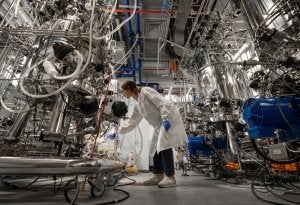New Cultured Meat Factory Will Churn Out 5,000 Bioreactor Burgers a Day

Share
In August 2013, food critics in London sampled the world’s first lab-grown hamburger. Opinions on taste and texture varied, but most agreed it wasn’t all that different than meat from an animal. At the time, the cultured meat’s taste and texture didn’t seem like too big of a concern, because the cost of making the burger—a cool $330,000—meant this technology was years away from reaching the average consumer.
Now, eight years later, an Israeli company called Future Meat Technologies has opened the world’s first facility to produce lab-grown meat at scale, in an inland city south of Tel Aviv called Rehovot. While the company hasn’t released an estimate of per-burger cost, it says the facility will be able to produce 500 kilograms of meat per day, which translates to about 5,000 burger patties.

Future Meat Technologies' cultured chicken breast
Though burger production costs remain a mystery, Future Meat’s website does say it’s already producing cultured chicken breasts at a cost of $3.90 apiece, breaking a price record in the industry. The average retail price of a boneless chicken breast in the US is $3.37, and that’s allowing for a profit for the producer and the retailer as well as covering the cost of transport and packaging.
Taken in this context, $3.90 is still quite high, and the figure will need to come down significantly to be competitive with factory-farmed meat—but it’s a far cry from the $330,000 burger, and costs will only continue to drop as the technology matures and operations scale.
“After demonstrating that cultured meat can reach cost parity faster than the market anticipated, this production facility is the real game-changer,” said Yaakov Nahmias, Future Meat Technologies founder and chief scientific officer, in a press release. “This facility demonstrates our proprietary media rejuvenation technology in scale, allowing us to reach production densities 10-times higher than the industrial standard.”
Be Part of the Future
Sign up to receive top stories about groundbreaking technologies and visionary thinkers from SingularityHub.



Inside Future Meat Technologies' facility in Rehovot
Cultured meat is made by extracting cells from animal tissue and giving them nutrients, oxygen, and moisture while keeping them at the same temperature they’d be at inside an animal’s body. The cells divide and multiply then start to mature, with muscle cells joining to create muscle fibers and fat cells producing lipids. The resulting nuggets of meat can be used to make processed products like burgers or sausages. Structured cuts of meat with blood vessels and connective tissue, like steak or chicken breast, require scaffolds, and researchers are creating these with biomaterials, like cellulose from plants. Companies are working on several varieties of more elaborate cultured products, from bacon to salmon.
As reported by Bloomberg, Future Meat aims to start offering its products in US restaurants by the end of next year—but must get approval from the FDA first. On top of that approval, public opinion is another hurdle the company and its competitors will need to clear before they see widespread success; for every person who’s opposed to factory farming, there’s a person who’s squeamish about the idea of meat grown in a bioreactor, despite the avian (or bovine, or porcine) lives being spared. Getting these consumers to view cultured meat favorably will be a matter of education, taste/texture as compared to the ‘real thing,’ and cost competitiveness.
Nahmias is up for the challenge. “Our goal is to make cultured meat affordable for everyone, while ensuring we produce delicious food that is both healthy and sustainable, helping to secure the future of coming generations,” he said.
Image Credit: Yeti studio / Shutterstock.com
Vanessa has been writing about science and technology for eight years and was senior editor at SingularityHub. She's interested in biotechnology and genetic engineering, the nitty-gritty of the renewable energy transition, the roles technology and science play in geopolitics and international development, and countless other topics.
Related Articles

Single Injection Transforms the Immune System Into a Cancer-Killing Machine

New Gene Drive Stops the Spread of Malaria—Without Killing Any Mosquitoes

New Immune Treatment May Suppress HIV—No Daily Pills Required
What we’re reading